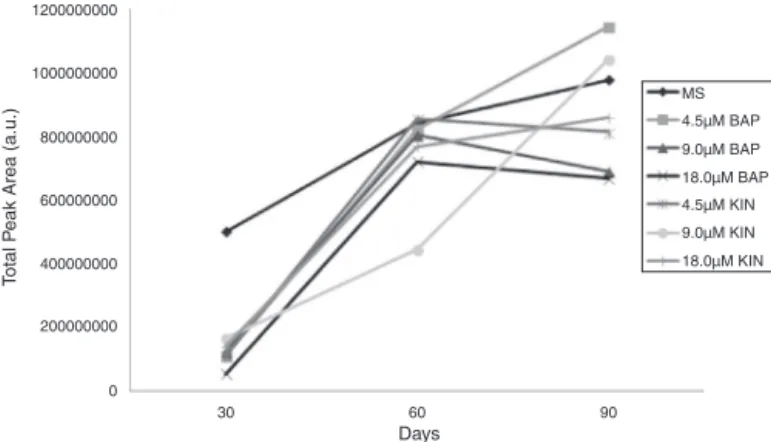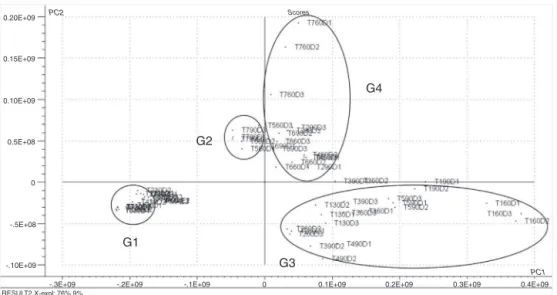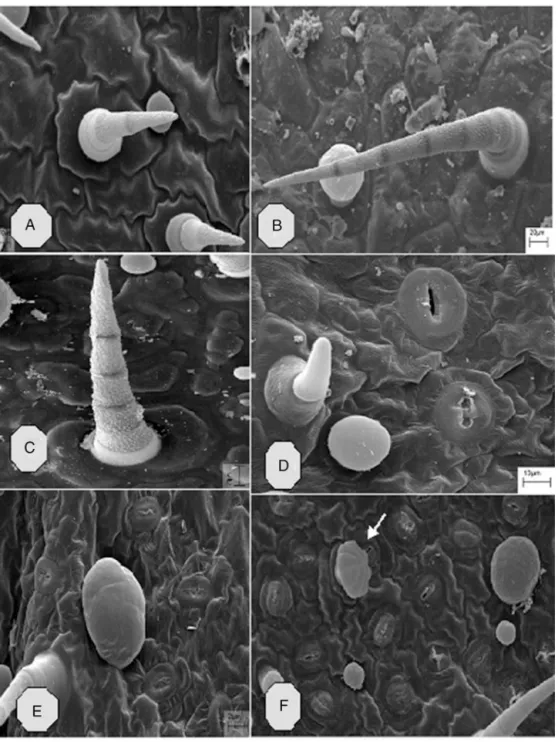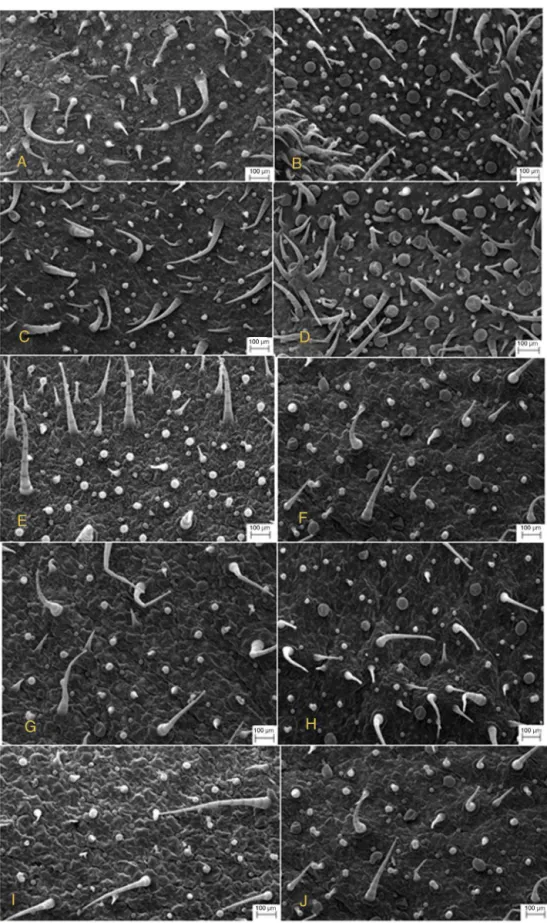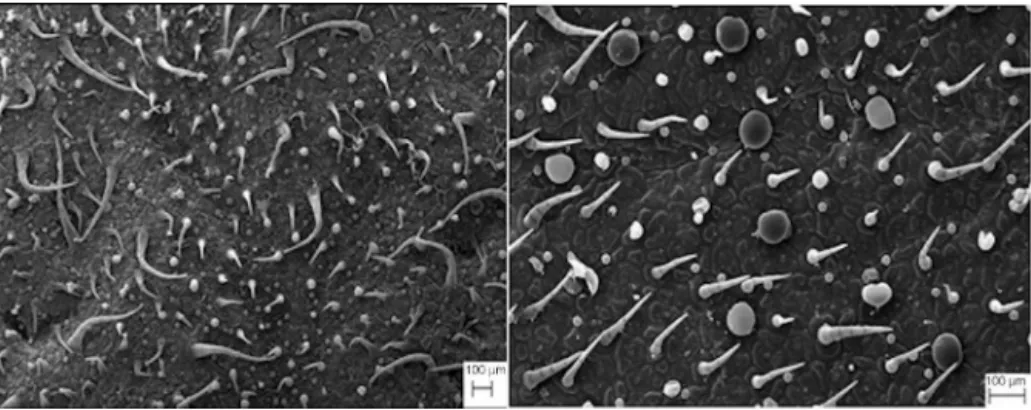RevistaBrasileiradeFarmacognosia27(2017)679–690
w ww . e l s e v i e r . c o m / l o c a t e / b j p
Original
Article
Influence
of
growth
regulators
on
distribution
of
trichomes
and
the
production
of
volatiles
in
micropropagated
plants
of
Plectranthus
ornatus
Helna
C.
Passinho-Soares
a,b,1,
Juceni
P.
David
a,∗,
José
R.F.
de
Santana
b,
Jorge
M.
David
c,
Frederico
de
M.
Rodrigues
d,
Paulo
R.R.
Mesquita
c,
Fábio
S.
de
Oliveira
e,
Moema
C.
Bellintani
faLaboratóriodePesquisadeProdutosNaturais,FaculdadedeFarmácia,UniversidadeFederaldaBahia,Salvador,BA,Brazil bProgramadePós-graduac¸ãoemBiotecnologia,UniversidadeEstadualdeFeiradeSantana,FeiradeSantana,BA,Brazil cInstitutodeQuímica,UniversidadeFederaldaBahia,Salvador,BA,Brazil
dEmpresaBaianadeDesenvolvimentoAgrícolaS.A.,Salvador,BA,Brazil
eCentrodeCiênciasdaSaúde,UniversidadeFederaldeRecôncavoBaiano,SantoAntôniodeJesus,BA,Brazil fInstitutodeBiologia,UniversidadeFederaldaBahia,Salvador,BA,Brazil
a
r
t
i
c
l
e
i
n
f
o
Articlehistory:
Received12May2017 Accepted10October2017 Availableonline21November2017
Keywords: Invitrocultivation Trichomes
Plantgrowthregulators VOC
Monoterpenes
a
b
s
t
r
a
c
t
Theprofileofvolatileorganiccompounds,theglandularandnon-glandulartrichomesofPlectranthus ornatus,obtainedbyinvitrocultivation,wasevaluatedinplantsgrowninMurashideandSkoogmedium supplementedwithbenylaminopurineat4.5,9.0,and18.0M+naphthaleneaceticacidat5.37M, kinetinat4.7,9.3and18.5M+naphthaleneaceticacid(5.37M)orMurashideandSkoog0medium (asacontrol).ScanningElectronMicroscopywasperformedonsamplesofthethirdleafnodeofthe90 daysoldplantsobtainedfromtreatmentwith4.5or9.0Mbenylaminopurine,and4.7or9.3Mkinetin. HeadspaceSolidPhaseMicro-Extractionofthe30,60and90daysoldinvitroplantspermittedto deter-minatebyGC/MSthecompositioncomprisedof62compounds.ThedatawereanalyzedusingPrincipal ComponentAnalysisandHierarchicalClusteringAnalysisand,themajorconstituentsoftheseoilsafter treatmentandagingweremonoterpenesandsesquiterpenes.Morphoanatomicalanalysisoftrichomes, byScanningElectronMicroscopy,enabledtheidentificationofnon-glandulartrichomesandfourtypes ofglandulartrichomes,whichcomprisedcapitateandpeltateglandulartrichomesthatweredistributed onbothsidesoftheleaf.Weobservedthattheregulatorsinfluencedqualitativeandquantitativeprofiles ofthevolatileorganiccompoundsandthenumberanddistributionofhairsontheleafsurface.
©2017SociedadeBrasileiradeFarmacognosia.PublishedbyElsevierEditoraLtda.Thisisanopen accessarticleundertheCCBY-NC-NDlicense(http://creativecommons.org/licenses/by-nc-nd/4.0/).
Introduction
Plectranthus ornatus Codd, Lamiaceae, is a perennial, succu-lent herb with a pleasant smell that is commonly used as an ornamentalplantinBraziliangardenswhereitisknownas “boldo-miudo”and“boldo-de-jardim.”Moreover,inBraziltheleavesof P. ornatus are used by locals to treat liver and stomach prob-lems,asasubstituteforP.barbatusAndrews(commonlyknown as“falso-boldo”).ResearchonthechemistryofsomePlectranthus species revealedthepresence of terpenoidsand phenolic com-poundsas typicalproductsof thesespecies.Theterpenoidsare consideredtobeprimarilyresponsibleforthecytotoxic,genotoxic,
∗ Correspondingauthor.
E-mail:juceni@ufba.br(J.P.David). 1Inmemoriam.
anti-fungal and anti-microbial activities of Plectranthus species (Lukhobaet al., 2006). Similarly, some Plectranthus species are rich sources of diterpenes. Other compounds, such as triter-penoidsofthelupaneand aristolaneclassesandsesquiterpenes andflavonoids,arealsofoundinthePlectranthusgenera( Abdel-Mogib et al., 2002; Gaspar-Marques et al., 2004, 2005, 2006). Forskolin-likediterpenoids,foundinleavesofP.ornatus,have anti-fungalactivitiesagainstCandidaandantibacterialactivitiesagainst Gram-positiveandGram-negativebacteria(Rijoetal.,2002). Fur-thermore,theessential oilof leavesofPlectranthus grandisand P.ornatuspresented antioxidantactivitiesand-caryophyllene, eugenol,germacreneDandthymolweredeterminatedasthemain constituentsofP.ornatusoils(deAlbuquerqueetal.,2007). Stud-iesofmicropropagationofmedicinalspecies,usingcellandtissue culture,areusedtosolvethevariabilityoftheproductionof sec-ondary metabolites due environmental and genetic factors. On
https://doi.org/10.1016/j.bjp.2017.10.001
680 H.C.Passinho-Soaresetal./RevistaBrasileiradeFarmacognosia27(2017)679–690
theotherhand,thereappearstobeaclosecorrelationbetween morphological and biochemical differentiations of cells, which allowsthe establishmentof metabolicpathwaysleading tothe biosynthesisofsecondarymetabolites(Turneretal.,2000;Tisserat andVaughn,2008).Inparticular,theterpenoidbiosynthesisis pro-ducedinspecializedglandswithinoronorgansurfaces.Cultures withoutthesestructuresappeartobecompetentinthe accumu-lationofterpenes(Tsuroetal.,2001;Kirakosyan,2006).Previous studiesdealingwiththeinductionofcallusfromnodalsegments ofP.ornatusdescribedtheeffectsofdifferentconcentrationsofthe 2,4-dichlorophenoxyaceticacid(2,4-D)and 1-naphthaleneacetic acid(NAA)intheproductionofvolatileorganiccompounds,mainly monoterpenesandsesquiterpenes(Passinho-Soaresetal.,2013). Theemploymentoftheseplantgrowthregulatorsalsopermitted toobtainanoverproductionofthebioactiverosmarinicacidand cinnamicacidderivatives(Medradoetal.,2017).
This work describes the effect of growth regulators on the volatileorganic compound profile obtainedby in vitro cultiva-tion of P. ornatus and measured using Headspace Solid Phase Micro-Extraction/gaschromatography coupled withmass spec-trometry (HS-SPME/GC–MS). The effect of these regulators on thedifferentiationoftheleavesbyevaluatingthemorphological changesbyScanningElectronMicroscopy(SEM)wasalso exam-ined.Importantly,despitealargenumberofmainlyultrastructural andhistochemicalstudiesofglandulartrichomesofmanyspecies (Serrato-Valentietal.,1997;Anaˇckovetal.,2009),invitrostudies arerare(Avatoetal.,2005)andinthecaseofinvitrocultivationof thespeciesP.ornatus,havenotbeenpublishedpreviously.
Materialsandmethods
Plantmaterial
The explants of Plectranthus ornatus Codd, Lamiaceae, were takenfrommotherplantscultivatedintheFacultyofPharmacy, FederalUniversityofBahia(UFBA).Avoucherhasbeendeposited attheHerbariumoftheNationalMuseum,FederalUniversityofRio deJaneiro,undernumberR196538.
Invitrocultures
Nodalsegmentsbearingaxillarybudswereselected,andthe leaveswereremoved.Theexplantswerecleanedbywashingin runningwaterfor40min,followedbytwowasheswithdistilled water. Using an aseptic chamber, the explantswere immersed inethanol(70◦GL)for1minwithagitationandtheninsodium hypochlorite (commercial product, 2% active chlorine)+Tween 20(20dropsl−1)for 15min.Theywerethenrinsedthree times (3×3min)withautoclaveddistilledwater.Followingdisinfection, theexplants (approximately 1.5cm in length) wereinoculated individually intotest tubes (25×150mm)containing 12ml MS medium(MurashigeandSkoog1962),solidifiedwith6gl−1agar and87.64mMsucroseandsupplementedwithdifferent concen-trationsofBAP(4.5,9.0or18.0M)+NAA(5.37M)andKIN(4.7, 9.3or18.5M)+NAA(5.37M).TheMSmediumwithout regu-lators(MS0)wasusedasa control.ThepHwasadjustedto5.7 beforeautoclavingandsterilizationwasperformedbyautoclaving at120◦Cfor15min.Theincubationswereperformedinagrowth roomthatwasmaintainedat25±2◦C,withanapproximately70% averageofhumidity.Thetesttubescontainingthemediumandthe explantswereclosedwithfilmcontainingnoplasticorPVC,kept inthedarkfor8daysandthensubmittedtoa16hphotoperiod (coolwhitelightof25molm−2s−1irradiance).Theplantswere evaluatedforvolatileorganiccompound(VOC)profilesat30,60 and90daysafterinoculation.
ExtractionandVOCanalyses
For extractionand VOCanalyses, headspaceand solid phase microextraction (HS-SPME) (Lord et al., 2003)techniques, cou-pledwithGC–MSanalysiswereemployed(Eicemanetal.,2002). Allextractionswereperformedintriplicate,onanidenticalmass ofplantshoot(1g)thatwasagedfor30,60or90daysinvitro. Initially,theshootwasmaceratedusingastickandaglass con-tainerof12mlcapacity.Thebottlewassealedwiththeappropriate sealerand withanaluminum lidandsilicone septumthat was Teflonfaced.Thesamplewasthenlefttostandfor20minatroom temperaturetoequilibratethevaporphase.Aholderneedlewith a 100m fiber coated of Polydimethylsiloxane/Divinylbenzene (PDMS/DVB)mounted ina syringe-like(Supelco,Bellefonte,PA, USA)wastheinsertedintothesamplevialwhere thefiberwas exposedandwhichwasheatedonaheatingplateat60◦Cduring 20min.Aftertheextractionandheating,thefiberwascollected on the same SPME microextrator and introduced directly into theinjectorofthechromatographequipment.Thevolatileswere thermally desorbedin the GC injector for 3minat 260◦C. The extractionparameters,suchassamplevolume(1g),equilibrium time (20min), extractiontime(15min), extractiontemperature (60◦C),desorptiontime(5min),desorptiontemperature(260◦C) andfiberextraction(PDMS-DVB),wereestablishedusing univari-ateandmultivariatetests.AnalyseswereconductedusingaGC–MS system(ShimadzuCG-2010/QP-2010highefficiency,coupledwith quadrupole mass detector). Helium, used as a carrier gas, was adjustedtoalinearvelocityof40cms−1(measuredat100◦C)with columnflowof1.22mlmin−1;theinjectionmodewassplitwith arateof1,30;thetemperatureoftheinjectorwassetto260◦C andtheoventemperaturegradientsetto50◦C(at0.0min), ris-ingat1.5◦Cmin−1 to80◦C(0.0min),then15◦Cmin−1 to160◦C (4min),20◦Cmin−1to250◦C(7min);withthetransferlinesetto 250◦C;theionsourceto250◦Candanimpactenergyof70eV.The totalruntime was40.5min.Theessentialoilconstituentswere identifiedbytheirretentionindices(RI)thatwereinturn deter-minedfromcalibrationcurvesofahomologousseriesofn-alkanes (C8–C32)injectedunderthesamechromatographicconditionsas thesamples,andtheywerealsoidentifiedanalyzingthe fragmen-tationpatterninthemassspectraandcomparisonwithdatafrom theliterature(Adams,2007)anddatabaseNIST147.
Multivariatedataanalyses
Thedataobtainedfromthesetypesofsamplesare multivari-ateandwethereforeusedthePrincipalComponentAnalysis(PCA) and HierarchicalCluster Analysis(HCA),which aremultivariate chemometricmethods,toidentifysimilaritiesandtrendsingroups ofcompoundsinducedbythedifferenttreatments.ThePCAand HCAwereusedtoevaluatetheprofilesofVOCfromtheinvitro explantsofP.ornatusthatwereinducedbythedifferenttreatments andobtainedusingHS-SPME/GC–MS.Theareasofthe chromato-graphicpeaksof62VOCweremeasuredfrom21differentsamples, 20ofwhichwererunintriplicateand1induplicate,andwereused toconstructadatamatrixofsize62×62.Thesoftwarepackages Unscramblerchemometrics8.0(CAMO)andStatistic7.0(Statsoft) wereusedforthePCAandHCAcalculations,respectively.
ScanningElectronMicroscopy(SEM)
H.C.
Passinho-Soares
et
al.
/
Revista
Brasileira
de
Farmacognosia
27
(2017)
679–690
681
Table1
HS-SPMEarea%ofvolatileorganiccompoundsofinvitroandexvitroPlectranthusornatus.
RT RI KI Compound 30days 60days 90days Matrice
T1a T2 T3 T4 T5 T6 T7 T1 T2 T3 T4 T5 T6 T7 T1 T2 T3 T4 T5 T6 T7 Exvitro
5.123 854 854 2-Hexenal 2.36 0.92 0.90 1.93 2.06 1.52 0.42 1.33 2.22 2.18 1.71 1.91 1.84 1.15 1.66 1.93 0.92 3.40 1.15 3.46 1.96 0.50
7.761 917 931 ␣-Thujene 15.76 32.65 30.16 28.12 19.09 31.83 23.54 17.06 14.11 12.68 15.95 19.67 22.14 31.67 13.46 24.30 17.66 14.12 14.01 25.09 24.15 13.64
8.074 926 939 ␣-Pinene 18.86 12.88 18.92 11.43 5.75 13.83 5.50 18.66 15.66 13.55 11.86 8.62 15.93 8.54 16.75 15.11 18.65 23.04 15.54 15.10 9.78 9.97
10.033 972 976 Sabinene 15.04 9.01 12.72 14.32 8.77 15.21 11.27 17.83 16.51 14.35 11.03 7.87 8.96 6.39 10.15 10.44 16.67 11.58 14.15 9.60 7.51 5.46
10.260 977 980 -Pinene 7.32 4.15 6.37 5.98 11.59 4.88 3.59 7.47 10.56 6.42 4.83 4.32 7.43 3.51 6.52 5.19 7.15 6.94 9.43 4.95 4.50 3.09
10.535 976 978 1-Octen-3-ol 4.38 2.23 2.68 4.67 0.56 3.01 1.75 5.30 3.34 5.66 11.11 8.51 8.88 4.03 3.41 9.02 5.59 7.89 4.30 4.80 8.10 9.23
11.031 992 991 -Myrcene 1.28 1.16 0.98 1.28 0.79 0.93 0.45 0.94 1.56 1.29 0.47 0.87 1.44 0.63 0.88 1.04 0.88 0.96 1.22 0.88 1.10 0.4
11.523 995 993 3-Octanol 0.75 1.02 0.63 1.13 0.91 0.56 0.37 0.75 1.88 1.55 1.84 2.40 3.10 1.02 0.59 3.19 0.36 1.19 0.94 0.58 1.38 0.81
12.037 1005 1004 Hexenolacetate – – – – – – – – – – – – – – – 0.57 – – – – – 0.16
12.225 1009 1005 ␣-Felandrene – – 0.12 – 0.29 – – – – – 1.26 – – – – – – – – – –
12.345 1011 1011 3-Carene 2.94 2.10 2.96 3.08 2.13 4.23 4.70 3.39 2.07 1.47 0.84 4.53 2.09 5.62 1.88 – 1.38 1.78 5.32 4.21 4.02
13.697 1033 1031 ␣-Limonene 1.65 1.00 1.28 1.43 1.19 1.70 0.90 1.00 1.69 1.37 – 0.68 1.65 0.99 1.14 1.17 0.90 1.37 1.41 0.95 0.81 0.43
13.850 1035 1033 1.8-Cineole 0.34 0.26 0.23 0.21 0.31 0.20 – – 0.30 0.26 – – 0.33 – 0.17 0.33 – 0.26 – – – 0.21
13.983 1038 1040 (Z)-ocimene 0.17 – 0.06 – – 0.14 – – 0.30 0.23 7.04 – – – – – – – – – – 2.54
14.674 1048 1050 (E)-ocimene 4.89 3.20 2.69 2.80 1.51 2.69 1.76 5.35 8.37 4.73 – 4.88 5.21 3.51 5.06 5.25 5.74 4.62 4.70 4.85 4.81
16.581 1074 1068 4-Thujanol 0.28 – 0.22 0.29 0.09 0.14 – – 0.37 0.26 – 0.27 0.36 – – 0.43 – 0.26 – – –
17.345 1083 1086 Isoterpinolene – – – – – 0.12 – – – – – – – – – – – – – – –
17.633 1087 1088 Terpinolene – – – – – 0.17 – – – – – – – – – – – – – – –
18.974 1098 1098 -Linalool 0.51 0.47 0.33 0.55 0.44 0.14 – – 1.00 0.53 – 1.05 – – 0.56 0.83 – – 0.94 – –
22.503 1135 1136 p-Menth-1-ol – – – 0.28 – – – 0.97 – – 0.14 – – – – 0.13 – 0.22 – 0.21 0.39
23.051 1141 1144 p-Menth-8-ol 0.15 0.21 0.15 – 0.13 0.08 0.09 – 0.49 0.45 0.14 0.37 0.38 – – 0.46 – – 0.19 – –
23.218 1142 1204 Decanal – – – – – – – – – – 0.11 0.14 – 0.28 – – – – – – – 0.1
24.751 1287 1285 Isobornyl
acetato
0.22 0.21 0.44 0.48 1.98 0.73 0.37 – – – – – – 0.78 – – – 0.17 – – –
25.524 1356 1351 ␣-Cubebene 0.57 – – 0.23 – – – 0.29 0.83 0.30 0.81 – 0.53 – 1.36 0.58 0.49 1.26 1.27 – – 0.69
25.626 1356 1350 ␣-Terpinyl
acetate
– 7.36 1.51 2.57 13.16 2.98 7.42 – – – – 1.99 – 3.23 – – – – – 1.69 1.32
25.940 1381 1376 ␣-Copaene 0.92 0.39 0.61 0.42 0.41 0.50 0.53 0.69 1.09 1.33 1.18 1.50 1.00 0.80 2.50 1.07 1.23 1.07 1.00 0.98 0.99 1.59
26.066 1389 1384 -Bourbonene – – – – – – – – – – 0.13 – – – 0.95 – 0.15 0.14 0.05 – 0.82 0.88
26.115 1392 1390 -Cubebene 1.26 – – 0.60 – – – 0.99 1.64 1.16 1.36 1.41 1.46 0.78 1.54 1.23 1.65 0.82 0.67 0.69 – 1.35
26.209 1397 1409 ␣-Gurjunene – – – – 0.81 0.52 1.00 – 0.16 0.13 0.11 – – – – – – 0.13 0.14 0.18 – 1.75
26.253 1399 1399 Azulene 1.24 1.09 0.67 0.78 3.96 1.50 4.47 0.18 – 0.13 – 0.82 0.17 3.26 0.17 0.10 – – – 0.71 1.34
26.385 1408 1403 -Isocumene – 1.46 1.18 2.01 – – – – – – – – – – – – – – – – –
26.618 1420 1418 
-Caryophyllene
5.84 5.02 4.36 3.89 9.33 3.90 9.79 5.05 7.02 13.60 11.59 9.86 6.45 6.10 9.89 6.06 7.79 7.46 8.14 7.01 7.71 30.34
26.767 1429 1432 -Gurjunene 0.29 – – 0.10 – – – 0.21 0.31 0.26 0.47 0.44 0.28 0.36 0.46 0.28 0.27 0.26 0.26 0.28 0.30 0.41
26.902 1438 1439 ␣-Guaiene – 0.10 0.10 0.05 1.09 – – 0.16 – – – – – – 0.15 – – – – – 0.11
26.964 1441 1443 (Z)-farnesene – – – – – – – 0.16 – – – – – 0.28 0.18 – 0.14 0.09 – 0.26 0.26 0.15
27.014 1444 1460 cis -Muurola-4(14).5-diene
0.24 – 0.08 – – – – – 0.18 0.14 0.14 0.38 0.16 – 0.30 0.20 0.15 – – 0.18 – 0.14
27.117 1450 1447 ␣-Himachalene 0.31 – – – 0.68 0.22 0.62 0.21 – 0.16 0.31 0.36 0.17 0.42 0.48 0.17 0.23 0.09 0.31 0.26 0.44
27.191 1454 1458 (E)-Farnesene – – – – – – – – – – – – – – – – – – – – – 0.18
27.208 1454 1454 ␣-Humulene 0.68 0.37 0.52 0.28 0.79 0.26 0.74 – 0.30 0.30 0.87 0.73 0.43 0.61 1.00 0.73 – 0.43 – 0.73 1.00 1.82
27.275 1459 1459 Aromadendrene – – 0.21 0.28 – – – – – – – – – – 0.19 – – – – – –
27.299 1460 1476 ␥-Himachalene – 0.41 – – – – – – – – – – – – – – – – – – –
27.433 1468 1461 allo
-Aromadendrene
– – – – – – – – – – – – – 0.14 – – – – – – – 0.19
682
H.C.
Passinho-Soares
et
al.
/
Revista
Brasileira
de
Farmacognosia
27
(2017)
679–690
Table1
(Continued)
RT RI KI Compound 30days 60days 90days Matrice
T1a T2 T3 T4 T5 T6 T7 T1 T2 T3 T4 T5 T6 T7 T1 T2 T3 T4 T5 T6 T7 Exvitro
27.506 1479 1485 -Ionone – – – – – – – – 0.24 – 0.47 – – – – – – – – – –
27.641 1479 1480 Germacrened 9.28 10.27 7.66 9.71 8.47 6.93 18.52 8.96 6.63 13.88 12.63 13.71 7.85 12.15 15.03 8.09 8.66 0.25 12.85 9.29 13.73 8.2
27.815 1489 1485 -Selinene 0.13 – – – – – – – – – – 0.19 – – 0.25 0.13 0.39 7.29 – 0.16 0.11 0.25
27.908 1494 1494 ␣-Selinene 0.25 – – – – – – – – 0.19 0.12 – – – 0.46 0.19 0.16 0.11 – 0.23 0.34
27.920 1494 1490 cis--Guaiene – – 0.11 – – – – – – – – – 0.07 – – – – 0.32 – – – 0.29
27.99 1498 1500 trans--Guaiene 0.34 – – – – – – 0.14 – 0.12 0.12 0.25 – – 0.12 0.16 0.16 – 0.35 – – 3.77
28.190 1509 1499 -Himachalene – – – – – 0.14 0.45 – – – – – – 0.52 – – – – – – 0.33
28.199 1510 1512 -Cucurmene – 0.18 0.13 0.15 – – – – – – – – – – – – – – – – –
28.218 1511 1511 ␣-Himachalene 0.14 – – – – – – 0.20 – 0.14 0.12 0.22 0.20 0.15 0.44 0.17 0.18 – 0.33 0.24 –
28.288 1514 1513 ␥-Cadinene 1.09 – – – – – – 1.96 0.67 0.73 1.03 0.82 0.65 1.08 1.56 1.01 2.06 0.24 0.99 0.69 1.37
28.298 1515 1517 ␣-Selinene – – – – – – – – – – – – – – – – – 1.09 – – –
28.475 1525 1556 Germacreneb – 0.08 – 0.55 – 0.40 0.80 – – – – – – – – – – – – – –
28.489 1525 1524 ␦-Cadinene – 0.82 0.59 – – – – – – – – – – – – – – – – 1.54 –
28.607 1532 1528 Kessane 0.27 – – – 1.12 – – 0.26 0.31 – – – 0.41 1.72 – – – 0.20 – – 0.84
28.827 1543 1542 Selina-3.7(11)-diene
– 0.99 0.35 0.37 2.58 – 0.82 – – – – – – – – – – – – – –
29.511 1527 1526 ␥-Himachalene – – – – – – 0.14 – – – – – – – – – – – – – –
29.636 1586 1574
Germacrene-d-ol
0.13 – 0.08 0.04 – – – 0.14 0.21 0.21 0.12 1.01 0.19 – 0.17 0.16 – 0.13 – – – 0.58
29.770 1592 1581 Caryophyllen
oxid
– – – – – 0.54 – – – – – – – – 0.15 – – 0.12 – – – 0.72
30.716 1641 1641 ␣-Muurolol – – – – – – – 0.14 – – 0.09 – – 0.29 – – – – – – 0.20 0.08
H.C.Passinho-Soaresetal./RevistaBrasileiradeFarmacognosia27(2017)679–690 683 1200000000 1000000000 800000000 600000000 400000000 200000000 0 30 60 Days 90 MS 4.5µM BAP 4.5µM KIN 9.0µM KIN 18.0µM KIN 9.0µM BAP 18.0µM BAP T otal P
eak Area (a.u.)
Fig.1.AverageofabsoluteareasofVOCresultingfromdifferenttreatments.
[37%formaldehyde,glacialaceticacidand70%ethanol(inaratioof 2,1,1)]andsubsequentlydehydratedinincreasingconcentrations ofacetone.Subsequently,thespecimenswerebroughttocritical pointdryingusingliquidCO2(BAL-TECCPD030),thenmetalized (BAL-TECSCD050)andexaminedusingSEM.
Resultsanddiscussion
TheHS-SPME/CG–MS-derivedconstituentsofessentialoilsof P.ornatusobtainedfromplantsgrownexvitroandinvitrowith differentconcentrationsof thecytokinins BAPandKIN and fol-lowing 30 (30D), 60 (60 D)or 90 (90 D)days of inoculation, areshowninTable1.Anumberof62volatilecompoundswere found,whichmainlycomprisedmonoterpenesandsesquiterpenes intheinvitroplants.Themajorconstituentsofessentialoils follow-ingtreatmentandagingwere␣-thujene(12.7–32.7%),␣-pinene (5.5–23%),sabinene(7.51–17.8%),-pinene(3.5–11.6%), 1-octen-3-ol(0.6–11.1%),3-carene(0.84–5.6%),(E)-ocimene(1.5–8.4%), ␣-terpinylacetate (1.3–13.2%),-caryophyllene (3.9–13.6%)and germacreneD(0.3–18.5%).
WithregardtothequantitativemeasurementswithGC–MS,we observedhigheraverageabsoluteareasofVOCinplantscultivated inMS0medium,independentoftheperiodofinoculation(Fig.1).In contrast,forexplantsgrownwithregulators,thehighestvaluesfor VOCwereobtainedwith4.5Mand18.0MBAPand18.5MKIN at60Dincubationandwith4.5Mand9.0MBAPand18.5M KINat 90 Dincubation.Whenwe analyzedthe different treat-mentswithineachage,weobservedthatforthe30Dincubation period,themajorVOC,␣-pinene(18.9%),1-octen-3-ol(4.4%)and (E)--ocimene(4.9%),reachedtheirhighestconcentrationswhen cultivatedinMS0(Table1).Inexplantsfromthesameincubation period(30D),theproductionofsabinene(15.0%)and␣-limonene (15.2%) appeared tobe independentof thepresence of regula-tors, given that theirconcentrations didnot differ significantly withtheadditionof9.0MBAP.Furthermore,VOCfromexplants growninMS0onlyalsohadthehighestconcentrationsof2-hexenal (2.4%),-myrcene(1.28%),1.8-cineol(0.3%),(Z)--ocimene(0.2%), 4-thujanol(0.3%),-linalool(0.51%),p-menth-8-ol(0.2%)and␣ -copaene(0.9%).Thepresenceof-selinene,␣-selinene,-guaiene, ␣-himachalene,␥-muuroleneand␥-cadinenewasobserved exclu-sivelyinexplantsincubatedfor30DinMS0(Table1).Additionally, major relative quantities of ␣-cubebene, -gurjunene and cis-muurola-4(14),5-dienewereobservedwiththis sametreatment andincubationperiod.Moreover,isoterpinoleneandterpinolene
were detected only in explants grown in BAP for 30 D days,
alloaromadendreneonlyinplantsincubatedinBAPfor60Dand -himachaleneonlyinexplantsgrowninBAPatallthreeperiods. Hexanolacetate,-isocumene,␥-himachalene,-cucurmeneand ␣-selineneweredetectedonlyintheexplantsculturedwithKIN.
WhenwecomparedtheconcentrationsofVOCineach treat-ment group withrespect to age(Table 1), the 60 D and 90 D explantsreachedthehighestpercenttotalcompound concentra-tion,especiallyinthoseundergoingtreatmentwithMS0,4.5M BAPor18.5MKIN.InTable1,weshowthe33VOCpresentinthe matrixfromexvitroplants,wherethemaincompounds(>1%)are␣ -thujene(13.6%),␣-pinene(∼10%),sabinene(5.5%),-pinene(3.1%), 1-octen-3-ol(9.2%),(E)--ocimene(2.54%),␣-copaene(1.6%), -cubebene (1.4%), ␣-gurjunene (1.8%), -caryophyllene (30.3%), ␣-humulene (1.8%), germacrene D (8.20%) and trans--guaiene (3.8%).
Therewasaqualitativeandquantitativechangeintheprofile ofvolatilecompoundsofexvitroplantswhencomparedwithVOC frominvitroplants.WhentherelativepercentofmajorVOCof exvitroplantswerecomparedwiththepercentVOCfrominvitro plantsgrowninculturemediumwithoutanygrowthregulators (MS0),weobservedayieldof14%and21%in␣-thujenoinplants agedfor30Dand60D,respectively.
Thepercentyieldfor␣-pineneattheperiodsanalyzed(30D, 60Dand90D)was89.6%87.2%and68.5%,respectively,andfor sabinene,theyieldswere172.7%,223.6%and85.5%,respectively. Further,the-pineneyield was135.5%, 141.9%and109.7%, the (E)--ocimeneyieldwas96%,116%and104%andthegermacrene Dyieldwas13.4%,9.8%and82.95%for30D,60Dand90D, respec-tively.However,therewasasignificantlossinpercentcontentof -caryophylleneinplantsincubatedwithmediumMS0invitro, with a decrease of approximately 522% yield compared to the contentofthiscompoundinexvitroplants.Theconsiderable pro-ductionofcaryophylleneinexvitroplantsmayberelatedtothe bioticandabioticstressfactorsthattheyaresubjectto.The syn-thesisof-caryophylleneinresponsetoattackbyherbivoreshas beendocumented(Köllneretal.,2008).
WhenwecomparedtheVOCresultsfromexvitroplants(using thehighestresultsfromeachtreatmentgroupatthethreedifferent ages)withthoseoftheinvitroplants,wenotedthatthepercent yieldofVOCobtainedinvitroismuchlargerthanthoseobtainedin theexvitroplants.SomeVOCshowedagainofover370%,suchas inthecaseof-pinene.
ThechromatographicprofileofVOCofinvitroandexvitroplants (Table1,Fig.1)revealsaqualitativeandquantitativechangethat isindependentoftheuseofregulatorsthataidinvitrocultivation (usingresultsfromMS0incubations).Anexceptiontothispattern is-caryophyllenewhosepercentageissignificantlyhigherinex vitroplants.However,theBAPandKINregulators,forthe60Dto90 Dagesandatconcentrationsof4.5Mand18.5M,respectively, positivelyinfluencedthequalitativeandquantitativeVOCprofile. PreviousstudieswithLavandulaviridisL’Hér.(Gonc¸alvesetal., 2008),LantanacamaraL.(Affonsoetal.,2007)andMelissaofficinalis L.(Silvaetal.,2005)showedthatthecontentofessentialoilsfound ininvitroplantsarehigherthanthosefromplantsgrownexvitro.A cytokine-inducedincreaseintheproductionofVOCwasobserved forThymusvulgarisL.(Affonsoetal.,2009)andLavanduladentata L.(Sudriáetal.,1999).Itisnoteworthythatalthoughthedefense systemsofhigherplantsarecorrelatedwithadaptationandthe demandsoftheirnaturalenvironment,theycanalsobeactivated byinvitrocultivationconditions(Tregearetal.,2002).
Thegraphoftheregulatorscores(PC1×PC2)isshowninFig.2. Eachpointrepresentsaparticulartreatment.Thescoreevaluations revealaclusterwithasignificantlysimilarchromatographic pro-file(G1).Incontrast,theotheridentifiedgroups(G2,G3andG4) arecomposedoftreatmentsthathavehigherdispersionsintheir chromatographicprofiles.
684 H.C.Passinho-Soaresetal./RevistaBrasileiradeFarmacognosia27(2017)679–690
PC2
PC1 0.20E+09
0.15E+09
0.10E+09
0.5E+08
0
-.5E+08
-.10E+09
-.3E+09 -.2E+09 -.1E+09 0 0.1E+09 0.2E+09 0.3E+09 0.4E+09
G3 G1
G2
G4
Scores
RESULT2,X-expl: 76%,9%
Fig.2.Graphofscores(PC1×PC2)obtainedbyPCAfromdataobtainedinthechromatographicanalysisofoilsshowingtheevaluationofdifferentregulators.Thetwofirst principalcomponentstogetherexplain85.4%ofthetotalvarianceofthedataset.T1=MS0;T2=18.5MKIN;T3=9.3MKIN;T4=4.7MKIN;T5=4.5MBAP;T6=9.0M BAP;T7=18MBAP.
0.8
0.6
0.6 0.4
0.4 0.5 0.2
0.2 0.3 -0.2
-0.1 0.1
0
0 -0.4
PC2
PC1 X-loadings
G4
G2
G1
G3
RESULT2, X-expl: 76%,9%
Fig.3.Graphoftheloadings(PC1×PC2)obtainedbyPCAfromdataobtainedinthechromatographicanalysisofoilsshowingtheevaluationofdifferentregulators.Thefirst twoprincipalcomponentstogetherexplain85.4%ofthetotalvarianceofthedataset.
valuesofpeakareasoftheseVOCareapproximatelyconstantin theexperiments.
AsshowninFig.3,thereplicatescontainedwithintheG2,G3or G4groupsdonothavesimilarityintheirchromatographicprofiles thatiscomparabletothatoftheG1group,asdemonstratedby thedendrogramobtainedfromtheanalysisusingtheHierarchical ClusterAnalysis(Fig.3).
TheG1groupincludes30Dexplantstreatedwith18.5MKIN (T230D),9.3MKIN(T330D),4.7MKIN(T430D),4.5MBAP (T530D),9.0MBAP(T630D),18MBAP(T730D)andtheexvitro plant.
TheG2groupcomprisesthe60Dexplanttreatedwith4.5M BAPandthe90Dexplanttreatedwith18MBAP,codifiedasT5 60DandT790D,respectively.TheG3groupiscomposedofexplants cultivatedinMS0for30,60or90days,encodedasT130D,T160D andT190D,respectively,inadditiontotheexplantscultivatedfor 60Dwith18.5MKIN(T260D)or9.3MKIN(T360D)and90D explantscultivatedwith4.7MKIN(T490D)or4.5MBAP(T5 90D).
TheG4groupincludestheexplantscultivatedfor60or90days with9.0MBAP,codifiedasT660DandT690D,respectively,and
theexplantscultivatedfor60or90Dwith18MBAP(T760D), inadditiontoexplantscultivatedfor60or90Dandtreatedwith 4.7MKIN(T460D),18.5MKIN(T290D)or9.3MKIN(T390D). EvaluationoftheresultspresentedinFigs.1and2showsthatthe G2groupofsamplesisinthesamequadrantas␣-terpinylacetate, indicatingthattreatmentsgroupedinG2have,onaverage,levels of␣-terpinylacetatethatareslightlylowerwhencomparedwith othertreatments.
Similarly,thegroupisinthesamequadrantofthegraphasthe VOC␣-pinene, sabinene,-pinene and(E)--ocimene.Thehigh valuesofloadingsindicatethat,onaverage,thelevelsoftheseVOC aremuchhigherintheG3groupthaninothergroups.
ThehighvaluesofloadingsoftheVOC␣-thujene,germacrene D,1-octen-3-oland3-carene,whichareinthesamequadrantas thetreatmentscontainedinG4,indicateacorrelationbetweenthis groupandtheseVOC.Further,thelevelsofthesecompounds,on average,arehigherinG4thaninothergroups.
H.C.Passinho-Soaresetal./RevistaBrasileiradeFarmacognosia27(2017)679–690 685
G1
0 5E7 1E8 1,5E8 2E8
Linkage distance
Fig.4.DendrogramobtainedfromHierarchicalClusterAnalysis(HCA).T1=MS0;T2=18.5MKIN;T3=9.3MKIN;T4=4.7MKIN;T5=4.5MBAP;T6=9.0MBAP; T7=18MBAP;PMAE=exvitroplant.
InFig.4,weshowthedendrogramobtainedfromtheHCA.The resultsobtainedbyHCAareinagreementwiththePCAresultswith regardtotheresemblanceintreatmentsoftheG1group(thisgroup showsgreatsimilarityinlevelsofdifferentVOC).Moreover,the widedispersionofscoresinthelevelsofVOCofothertreatments, includingthedisparatereplicates,reflectsthedifficultyindefining theothergroupsbyHCA.
ThedataobtainedbyHCAindicatethattreatmentsthatarenot partoftheG1groupcanbeframedintoalargegroup.However, theseresultsdonotdisagreewiththoseobtainedbyPCAbecause inthislattertechnique,thegroupsaremadebyvisualinspection andwilldependuponhumaninspection.Thus,evenwithPCA,the datacanbeconsideredastwogroupsonly,thosebelongingtoG1, whicharemuchmoresimilartoeachother,andothertreatments gatheredintoanotherlargegroup.Thus,itcanbeconcludedthat thebestmethodsfortheinvitroproductionofVOCinP.ornatusare toincubateinMS0(control),followedbytreatmentwith4.5M BAPorbytreatmentwith18.5MKIN.
Using SEM, we observed that in vitro P. ornatus has non-glandulartrichomesandcapitateandpeltateglandulartrichomes thataredistributedonbothadaxialandabaxialleafsurfaces.Three typesofnon-glandulartrichomeswereobserved.TypeI(Fig.5A–D) aresimple, short,bicellular, uniseriatetrichomeswithanacute apexandgranularsurfacethatarearrangedonabroadbasethatis unicellularorbicellularwithasmoothsurface.Similartrichomes wereobservedforthespeciesMicromeriamarginata(Sm.)Chater (Moonetal.,2009).Thenon-glandulartrichometypeII(Fig.5Band C),measuring75–500minlength,wereuniseriates, multicellu-lar,consistedofthreetoeightcellswithagranularsurfaceandwere arrangedonabasalcellwithasmoothsurfaceof40minwidth. Weobserved(Fig.5A–C) thattheunionofeach cellwasclearly marked.Thepresenceofthesetypesoftrichomesisinagreement
withreportsintheliterature(Ascensãoetal.,1999)ofinvivo tri-chomesofP.ornatus.TypeIIIwerenon-glandulartrichomesand weresimpleandunicellular,withasmoothsurfaceandrounded apex,andlayonaunicellularbase.
Wealsoobservedpeltateglandulartrichomeslocatedonthe abaxialleafsurfacethatwerecomposedofabasalcellandabulky roundedheadmeasuring60–100minheightand45–70min diameter (Fig.5Eand F) and composedofeight secretory cells arranged in a circle (Fig. 5F). Based on the morphology of the glandularheadandthedimensionsofthestalk,fourtypesof cap-itateglandulartrichomeswereidentified,typeI(Fig.6A–C),type II(Fig.6D–G),typeIII(Fig.6H–I)andtypeIV(Fig.6I).TypeI cap-itatetrichomeshavearound,unicellular,glandularhead(Fig.6A) orbicellularhead(Fig.6B)andashortunicellularormulticellular stalk(Fig.6C).
TypeIIcapitatetrichomesareunicellular,withaconicalstalk ofvariablelength(Fig.6D–G)andaglandularheadthatisrounded andunicellular.Belowtheglandularhead,weobservedaclearly differentiatedneck-cell(Fig.6EandF).
TypeIIIcapitatetrichomesaremulticellularanduniseriate.They consistof4–7smoothsurfacecells,adifferentiatedneck-cellandan oval,unicellularandglandularhead.Asinnon-glandulartrichomes, thereareclearmarkstoshowtheunionofthecellsthatformits stalk(Fig.6H).
686 H.C.Passinho-Soaresetal./RevistaBrasileiradeFarmacognosia27(2017)679–690
Fig.5.ScanningElectronMicrographofnon-glandular(A–D)andglandularpeltatetrichomes(E–F)inleavesofinvitroPlectranthusornatus.
Ourresultscontrastedwithreportsfromtheliteratureusingin vivocultivatedP.ornatus(Ascensãoetal.,1999).Wefoundthat nei-therinvitronorinvivocultivatedP.ornatusshowedthepresenceof glandulardigitiformtrichomes.Moreover,unliketheobservations madewithcultivatedinvivoP.ornatus,wherethepresenceoftwo typesofcapitatetrichomesonlywerereported,here,using cul-tivatedinvitroP.ornatus,weidentifiedfourmorphologicaltypes ofcapitateglandulartrichomes(Fig.6A–J).Theeffectofgrowth regulatorsonthetrichomedistributionontheadaxialandabaxial sidesoffoliarlaminaisshown(Fig.7A–J).Inaddition,thisfigure illustratesthedistributionoftrichomesonadaxial(Fig.7A)and abaxialsides(Fig.7B)ofplantsgrowninMS0.Theleavestreated with4.5MBAP+NAA(5.4M)areillustratedinFig.7CandD. TreatmentwithMS0andwith4.5MBAP+NAA4.5Minduceda largernumberofpeltateglandulartrichomeswhencomparedwith othertreatmentsandtheexvitroplant(Figs.7E–Jand8AandB).
Theeffectoftreatmentwith9.0MBAP+4.5MNAAisillustrated inFig.7(EandF)andshowsareductioninthenumberof non-glandulartrichomes,especiallyontheabaxialside(Fig.7F)when comparedwithexvitroplants(Fig.8B).Theeffectoftreatmentwith 4.7Mand9.3MKIN+5.4NAAisillustratedinFig.7(G–I).When thistreatmentiscomparedwithplantscultivatedinMS0medium andwiththeexvitroplant,weobservedasignificantdecreasein thetotalnumberofglandularandnon-glandulartrichomes.
Theseresultsindicatethatthegrowthregulatorsaddedtothe culturemediumofinvitroP.ornatusaffectednotonlythe qual-itative and quantitativeprofile of VOC,but alsothe density of trichomes.SimilarresultswereobservedusingL.dentata(Sudriá etal.,1999).
H.C.Passinho-Soaresetal./RevistaBrasileiradeFarmacognosia27(2017)679–690 687
Fig.6.ScanningElectronMicrographofglandularcapitatetrichomesinleavesofPlectranthusornatuscultivatedinvitro.A–C,typeIcapitatetrichomes.A,Cuticlecover recoveringtheheadoftheglandulartrichome.B,Peltatetrichomeshowingtheglandularbicellularhead.C,Unicellularglandularheadandbaseofthemulticellulartrichome. D–G,TypeIIcapitatetrichomes.D,Cuticlecoverrecoveringtheheadofmulticellularglandulartrichome.E,Theneckcellofthetrichome.F,TypeIandtypeIIcapitatetrichomes andpeltatetrichome.H-I,TypeIIItrichomes.H,Panoramicviewoftheadaxialepidermiswithnon-glandulartrichomesandtypeIIIcapitatetrichomes.I,Aglandularoval head.J,TypeIVtrichomes,showingabicellularbaseandstalkcellswithclearlyvisiblecells.
levelsofirradiance(Stengleinetal.,2005).Theglandulartrichomes areresponsibleforthestorageandsecretionofseveral phytochem-icalcompoundsthatcanaltertheleaftasteorthatcanbetoxic,thus protectingplantsagainstherbivoreattack.Severaltrichome chem-icals haveproven pharmacologicaleffects (Siebert, 2004;Sousa etal.,2008;Martinsetal.,2009).
Thedensityoftrichomesonplantscanvaryduetogeneticand environmentalfactors(ForknerandHare,2000).Inthisstudy,we observedthattheleavesofplantscultivatedinvitroinMS0orin
mediumsupplementedwith4.5MBAPshowedhighernumbers
ofabaxialsideglandulartrichomes.Thisfindingmaybecorrelated withtheincreasedproductionofVOCthatwasobservedwiththese conditionsbecausetrichomesaredirectlyinvolvedwiththestorage
andsecretionofphytochemicalcompounds(Alaimoetal.,2005; Bussottietal.,1977).
Therefore,eventhoughphysiological,anatomicaland biochem-icalcharacteristicsofplantsaregenotype-derived,factorssuchas theuseofphytoregulatorsandthecompositionofculturemedium exertarobustinfluenceontheexpressionofregulatorsinvolvedin thedefenseprocessandorganogenesisinvitro.
Conclusions
688 H.C.Passinho-Soaresetal./RevistaBrasileiradeFarmacognosia27(2017)679–690
Fig.7.AScanningElectronMicrographdemonstratestheeffectofgrowthregulatorsinthedistributionoftrichomesontheadaxialandabaxialfaces,respectively,fromthe leavesofPlectranthusornatusinvitro.AandB,MS0.CandD,4.5MBAP+5.4MNAA.EandF,9.0MBAP+5.4MNAA.GandH,4.7MKIN+5.4MNAA.IandJ,effect of9.3MKIN+5.4MNAA.
mechanismsandfactorsthatinfluencethebiosynthesisof metabo-litesandthedifferentiationofplantsgrowninvitrocontributesto thedevelopmentofnewapproachesforproducingplants compe-tentinacclimatization,thusproducingnewcompoundsofinterest.
Authorcontributions
H.C.Passinho-Soaresetal./RevistaBrasileiradeFarmacognosia27(2017)679–690 689
Fig.8. AScanningElectronMicrographofexvitroplants.A,adaxialface.B,abaxialsides.
discussionandwriting.JRFS andMCBweretheresponsiblesfor alltheinvitrocultivationandmicropropagationsupervising.JMD contributedwithchemicalanalysisandcriticalreading.FMRand PRRMdidtheHSPMextractionsandGCanalysis.FSOworkedwith PCAandHCAanalysis.
Conflictsofinterest
Theauthorsdeclarenoconflictsofinterest.
Acknowledgements
Thisworkwasinpartfundedwithgrantsandfellowshipsby CNPqandFundac¸ãodeAmparoaPesquisadoEstadodaBahia.We areindebtwithDr.JailsonB.deAndrade(UFBA)bythefacilities foralltheGC/MSdataanalysisandquantificationofVOC.
References
Abdel-Mogib,M.,Albar,H.A.,Batterjee,S.M.,2002.Chemistryofthegenus Plectran-thus.Molecules7,271–301.
Adams,R.P.,2007.IdentificationofEssentialOilComponentsbyGas Chromatogra-phy/MassSpectrometry,4thed.AlluredPublishingCorporation,CarolStream, IL,pp.804.
Affonso,V.R.,Bizzo,H.R.,Lage,C.L.S.,Sato,A.,2009.Influenceofgrowthregulators inbiomassproductionandvolatileprofileofinvitroplantletsofThymusvulgaris L.J.Agric.FoodChem.57,6392–6395.
Affonso,V.R.,Bizzo,H.R.,Lima,S.S., Esquibel,M.A.,Sato,A., 2007.Solidphase microextraction(SPME)analysisofvolatilecompoundsproducedbyinvitro shootsofLantanacamaraL.undertheinfluenceofauxinsandcytokinins.J.Braz. Chem.Soc.18,1504–1508.
Alaimo,M.G.,Vizzı,D.,Melati,M.R.,2005.Histochemical propertiesandtrace elementconcentrationsinParietariaL.fromurbansites(Palermo,Italy). Aer-obiologia21,21–31.
Anaˇckov,G.,Boˇzin,B.,Zori ´c,L.,Vukov,D.,Mimica-Duki ´c,N.,Merkulov,L.,Ruˇzica, I.,Jovanovi ´c,M.,Boˇza,P.,2009.Chemicalcompositionofessentialoilandleaf anatomyofSalviabertoloniiVis.andSalviapratensisL.(Sect.Plethiosphace, Lami-aceae).Molecules14,1–9.
Ascensão,L.,Mota,L.,Castro,M.M.,1999.Glandulartrichomesontheleavesand flowersofPlectranthusornatus.Morphology,distributionandhistochemistry. Ann.Bot.84,437–447.
Avato,P.,Fortunato,I.M.,Ruta,C.,D’Elia,R.,2005.Glandularhairsandessentialoils inmicropropagatedplantsofSalviaofficinalisL.PlantSci.169,29–36. Bussotti,F.,Grossoni,P.,Bottacci,A.,1977.Sclerophyllyinbeech(FagussylvaticaL.)
trees,itsrelationshipwithcrowntransparency,nutritionalstatusandsummer drought.Forestry70,267–271.
deAlbuquerque,R.L.,daSilva,M.G.V.,Machado,M.I.L.,Matos,F.J.A.,deMorais,S.M., Stone-Neto,J.,2007.Chemicalcompositionandantioxidantactivityof Plectran-thusgrandisandP.ornatusessentialoilsfromnorth-easternBrazil.FlavourFragr. J.22,24–26.
Eiceman,G.A.,Nazarov,E.G.,Miller,R.A.,Krylov,E.V.,Zapata,A.M.,2002. Micro-machined planar field asymmetric ion mobility spectrometer as a gas chromatographicdetector.Analyst127,466–471.
Forkner,R.E.,Hare,J.D.,2000.Geneticandenvironmentalvariationinacylglucose esterproductionandglandularandnonglandulartrichomedensitiesinDatura wrightii.J.Chem.Ecol.26,2801–2823.
Gaspar-Marques,C.,Rijo,P.,Simões,M.F.,Duarte,M.A.,Rodriguez,B.,2006. Abi-etanesfromPlectranthusgrandidentatusandP.hereroensisagainst methicillin-andvancomycin-resistantbacteria.Phytomedicine13,267–271.
Gaspar-Marques,C.,Simões,M.F.,Rodríguez,B.,2005.Atrihomoabietane diter-penoidfromPlectranthusgrandidentatusandanunusualadditionofacetoneto theorto-quinonesystemofcryptotanshinone.J.Nat.Prod.68,1408–1411. Gaspar-Marques,C.,Simões,M.F.,Rodríguez,B.,2004.Furtherlabdaneandkaurane
diterpenoidsandotherconstituentsfromPlectranthusfruticosus.J.Nat.Prod.67, 614–621.
Gonc¸alves, S., Serra, H., Nogueira, J.M.F., Almeida, C.R.L., Romano, A., 2008. Headspace-SPMEof invitroshoot-culturesand micropropagatedplantsof Lavandulaviridis.Biol.Plant.52,133–136.
Kirakosyan,A.,2006.Plantbiotechnologyfortheproductionofnaturalproducts.In: Cseke,L.J.,Kirakosyan,A.,Kaufman,P.B.,Warber,S.,Duke,J.A.,Brielmann,H.L. (Eds.),NaturalProductsfromPlants.,2nded.CRCPress,Taylor&Francis,Boca Raton,FL,pp.222–256.
Köllner,T.G.,Held,M.,Lenk,C.,Hiltpold,I.,Turlings,T.C.J.,Gershenzon,J.,Degenhardt, J.,2008.Amaize(E)--caryophyllenesynthaseimplicatedinindirectdefense responsesagainstherbivoresisnotexpressedinmostAmericanmaizevarieties. PlantCell20,482–494.
Lord,H.L.,Grant, R.P.,Walles,M.,Incledon,B.,Fahie,J.B.,Pawliszyn,B.,2003. Developmentandevaluationofasolid-phasemicroextractionprobeforinvivo pharmacokineticstudies.Anal.Chem.75,5103–5115.
Lukhoba,C.W.,Simmonds,M.S.J.,Paton,A.J.,2006.Plectranthus,areviewof ethnobo-tanicaluses.J.Ethnopharmacol.103,1–24.
Martins,M.B.G.,Graf,R.R.,Cavalheiro,A.J.,Rodrigues,S.D.,2009.Pharmacognostic characterizationofleavesandseedsofAlbizialebbeck(L.)Benth,(Fabaceae).Rev. Bras.Farmacogn.19,106–114.
Medrado,H.H.,dosSantos,E.O.,Ribeiro,E.M.O.,David,J.M.,David,J.P.,Araújo,J.F., doVale,A.E.,Bellintani,M.C.,Brandão,H.N.,Meira,P.R.,2017.Rosmarinicand cinnamicacidderivativesofinvitrotissuecultureofPlectranthusornatus. Over-productionandcorrelationwithantioxidantactivities.J.Braz.Chem.Soc.28, 505–511.
Moon,H.K.,Hong,S.P.,Smets,E.,Huysmans,S.,2009.Phylogeneticsignificanceof leafmicromorphologyandanatomyinthetribeMentheae(Nepetoideae, Lami-aceae).Bot.J.Linn.Soc.160,211–231.
Passinho-Soares,H.,Meira,P.R.,David,J.P.,Mesquita,P.R.R.,doVale,A.E.,Rodrigues, F.M.,Pereira,P.A.P.,Santana,J.R.F.,Oliveira,F.S.,deAndrade,J.B.,David,J.M., 2013.Volatileorganiccompoundsobtainedbyinvitrocalluscultivationof Plec-tranthusornatusCodd.(Lamiaceae).Molecules18,10320–10333.
Rijo,P.,Gaspar-Marques,C.,Simões,M.F.,Duarte,A.,Apreda-Ojas,M.D.,Cano,F.H., Rodriguez,B.,2002.NeoclerodaneandlabdanediterpenoidsfromPlectranthus ornatus.J.Nat.Prod.65,1387–1390.
Serrato-Valenti,G.,Bisio,A.,Cornara,L.,Ciarallo,G.,1997.Structuraland histo-chemicalinvestigationoftheglandulartrichomesofSalviaaureaL.leaves,and chemicalanalysisoftheessentialoil.Ann.Bot.79,329–336.
Siebert,D.,2004.LocalizationofsalvinorinAandrelatedcompoundsinglandular trichomesofthepsychoactivesage,Salviadivinorum.Ann.Bot.93,763–771. Silva,S.,Sato,A.,Lage,C.L.S.,Gil,R.A.S.S.,Azevêdo,D.A.,Esquibel,M.A.,2005.Essential
oilcompositionofMelissaofficinalisL.invitroproducedundertheinfluenceof growthregulators.J.Braz.Chem.Soc.16,1387–1390.
Sousa,F.C.F.,Melo,C.T.V.,Citó,M.C.O.,Félix,F.H.C.,Vasconcelos,S.M.M.,Fonteles, M.M.F.,Barbosa-Filho,J.M.,Viana,G.S.B.,2008.Medicinalplantsandtheir bioac-tiveconstituents,ascientificreviewofbioactivityandpotentialbenefitsinthe anxietydisordersinanimalmodels.Rev.Bras.Farmacogn.18,642–654. Stenglein,S.A.,Arambarri,A.M.,Menendez-Sevillano,M.C.,Balatti,P.A.,2005.Leaf
epidermalcharacters related with plant’spassiveresistance to pathogens vary among accessions of wild beans Phaseolus vulgaris var. aborigineus (Leguminosae-Phaseoleae).Flora200,285–295.
Sudriá,C.,Pi ˜nol,M.T.,Palazón,J.,Cusidó,R.M.,Vila,R.,Morales,C.,Bonfill,M., Ca ˜nigueral,S.,1999.Influenceofplantgrowthregulatorsonthegrowthand essentialoilcontentofculturedLavanduladentataplantlets.PlantCellTissue Org.58,177–184.
Tisserat,B.,Vaughn,S.F.,2008.Growth,morphogenesis,andessentialoil produc-tioninMenthaspicataL.plantletsinvitro.InVitroCell.Dev.Biol.-Plant44, 40–50.
690 H.C.Passinho-Soaresetal./RevistaBrasileiradeFarmacognosia27(2017)679–690
oilpalminflorescences,inductionduringtissuecultureandpossibleassociation withepigeneticsomaclonalvariationevents.J.Exp.Bot.53,1387–1396. Tsuro,M.,Inoue,M.,Kameoka,H.,2001.Variationinessentialoilcomponentsin
regeneratedlavender(LavandulaveraDC)plants.Sci.Hortic.88,309–317.
